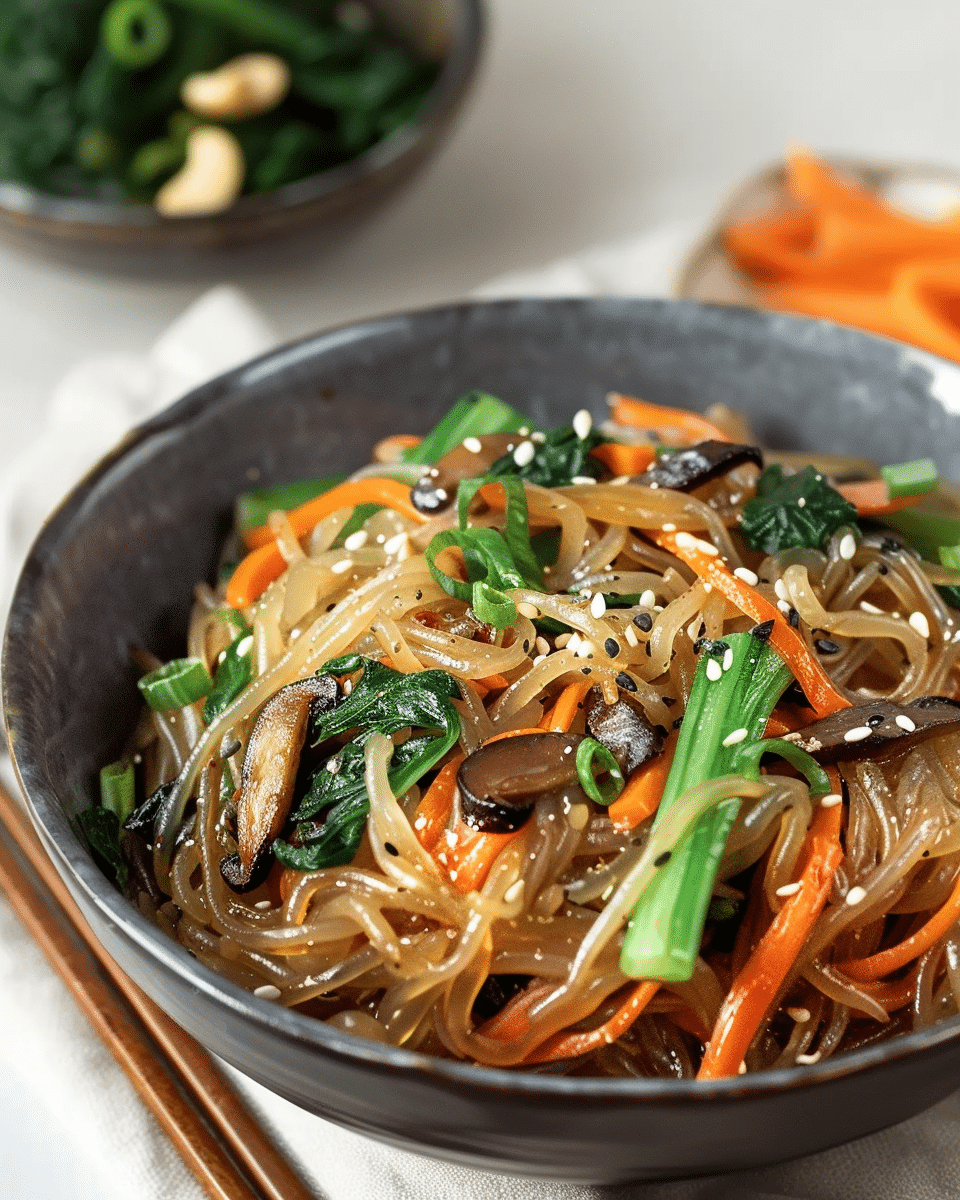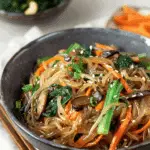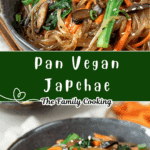Why You’ll Love This Recipe
This Pan Vegan Japchae is an easy-to-make, comforting dish packed with flavor and nutrition. It combines chewy sweet potato glass noodles with a variety of crisp, sautéed vegetables like spinach, carrots, mushrooms, and onions. The dish is seasoned with a savory sauce made from soy sauce, sesame oil, and a hint of sweetness. It’s satisfying enough for a main course but also works great as a side dish or meal prep option. It’s naturally vegan, gluten-free (if using gluten-free soy sauce), and full of vibrant colors that make it as appealing to the eyes as it is to the taste buds.
Ingredients
-
200g sweet potato glass noodles (dangmyeon)
-
1 tablespoon sesame oil
-
1 tablespoon soy sauce (use gluten-free soy sauce if needed)
-
1 tablespoon maple syrup or agave syrup
-
1 teaspoon sesame seeds (for garnish)
-
1 tablespoon vegetable oil (for stir-frying)
-
1 medium carrot, julienned
-
1 cup spinach leaves
-
1 small onion, thinly sliced
-
1 cup shiitake mushrooms, sliced (or any preferred mushroom)
-
2 cloves garlic, minced
-
1 tablespoon rice vinegar
-
1 tablespoon soy sauce (for stir-frying)
-
½ teaspoon black pepper
-
1 tablespoon toasted sesame oil (optional, for extra flavor)
(Tip: You’ll find the full list of ingredients and measurements in the recipe card below.)
Directions
-
Cook the noodles: Bring a pot of water to a boil. Add the sweet potato glass noodles and cook according to the package instructions, usually around 6-8 minutes. Once cooked, drain the noodles and rinse under cold water to stop the cooking process. Set aside.
-
Prepare the sauce: In a small bowl, whisk together 1 tablespoon soy sauce, 1 tablespoon maple syrup, 1 tablespoon sesame oil, and rice vinegar. Set aside.
-
Stir-fry the vegetables: Heat vegetable oil in a large skillet or wok over medium heat. Add the garlic and onions and sauté for 2-3 minutes until fragrant. Add the mushrooms and carrots, and stir-fry for another 5-7 minutes until the vegetables are tender and slightly caramelized. Toss in the spinach and cook for another minute until wilted.
-
Combine the noodles and sauce: Add the cooked noodles to the pan with the vegetables. Pour the prepared sauce over the noodles and toss everything together, making sure the noodles are evenly coated with the sauce. Stir-fry for an additional 2-3 minutes.
-
Garnish and serve: Remove from heat and sprinkle with sesame seeds. Serve warm and enjoy!
Servings and Timing
-
Servings: 4
-
Prep Time: 15 minutes
-
Cook Time: 15 minutes
-
Total Time: 30 minutes
Variations
-
Protein boost: Add tofu or tempeh for a protein-packed version of this dish. You can sauté the tofu in the pan with the vegetables to crisp it up.
-
Vegetable swaps: Feel free to substitute other vegetables like bell peppers, zucchini, or broccoli. Japchae is highly versatile and can be customized to your liking.
-
Spicy Japchae: Add a touch of gochujang (Korean chili paste) or red pepper flakes to the sauce for a spicy kick.
Storage/Reheating
-
Storage: Leftover Japchae can be stored in an airtight container in the fridge for up to 3 days.
-
Reheating: To reheat, place the leftovers in a pan over medium heat with a splash of water or vegetable broth to prevent it from drying out. Stir-fry for 3-5 minutes until heated through.
FAQs
Can I make this dish gluten-free?
Yes! Simply use gluten-free soy sauce or tamari instead of regular soy sauce.
Can I add meat to this dish?
Absolutely! If you’re not vegan, you can add thinly sliced beef, chicken, or even shrimp for a non-vegan version.
Can I use other types of noodles?
Yes, you can substitute the sweet potato glass noodles with other Asian noodles like soba or rice noodles. Just note that the texture and flavor may change slightly.
How long does Japchae last in the fridge?
Japchae can be stored in an airtight container in the fridge for up to 3 days.
Can I freeze leftover Japchae?
While Japchae is best fresh, it can be frozen for up to a month. Just be aware that the texture of the noodles may change once thawed.
Can I use frozen spinach instead of fresh?
Yes, you can use frozen spinach. Just be sure to thaw and drain it properly before using.
Can I make the sauce in advance?
Yes, you can prepare the sauce ahead of time and store it in the fridge for up to a week.
Is Japchae spicy?
Traditional Japchae is not spicy, but you can add chili paste or red pepper flakes to make it spicy if you prefer.
How do I make Japchae more savory?
To make Japchae more savory, you can add more soy sauce or a little miso paste to the sauce for depth of flavor.
Can I serve Japchae cold?
Yes, Japchae can be enjoyed cold as a refreshing salad. It’s delicious either way!
Conclusion
This Pan Vegan Japchae is a flavorful, nutritious, and customizable dish that can be enjoyed as a main or side. It’s quick to prepare, making it ideal for busy weeknights or meal prep. With its chewy noodles, vibrant vegetables, and savory-sweet sauce, it’s sure to satisfy your taste buds and become a go-to in your plant-based recipe rotation. Enjoy it fresh, or store it for later, and take delight in this Korean-inspired vegan treat!
Pan Vegan Japchae
5 Stars 4 Stars 3 Stars 2 Stars 1 Star
No reviews
Pan Vegan Japchae is a plant-based version of the traditional Korean dish made with stir-fried glass noodles, vegetables, and a savory-sweet sauce.
- Author: Laura
- Prep Time: 15 minutes
- Cook Time: 15 minutes
- Total Time: 30 minutes
- Yield: 4 servings
- Category: Main or Side Dish
- Method: Stir-frying
- Cuisine: Korean
- Diet: Vegan
Ingredients
- 200g sweet potato glass noodles (dangmyeon)
1 tablespoon sesame oil
1 tablespoon soy sauce (use gluten-free soy sauce if needed)
1 tablespoon maple syrup or agave syrup
1 teaspoon sesame seeds (for garnish)
1 tablespoon vegetable oil (for stir-frying)
1 medium carrot, julienned
1 cup spinach leaves
1 small onion, thinly sliced
1 cup shiitake mushrooms, sliced (or any preferred mushroom)
2 cloves garlic, minced
1 tablespoon rice vinegar
1 tablespoon soy sauce (for stir-frying)
½ teaspoon black pepper
1 tablespoon toasted sesame oil (optional, for extra flavor)
Instructions
Cook the noodles: Bring a pot of water to a boil. Add the sweet potato glass noodles and cook according to the package instructions, usually around 6-8 minutes. Once cooked, drain the noodles and rinse under cold water to stop the cooking process. Set aside.
- Prepare the sauce: In a small bowl, whisk together 1 tablespoon soy sauce, 1 tablespoon maple syrup, 1 tablespoon sesame oil, and rice vinegar. Set aside.
- Stir-fry the vegetables: Heat vegetable oil in a large skillet or wok over medium heat. Add the garlic and onions and sauté for 2-3 minutes until fragrant. Add the mushrooms and carrots, and stir-fry for another 5-7 minutes until the vegetables are tender and slightly caramelized. Toss in the spinach and cook for another minute until wilted.
- Combine the noodles and sauce: Add the cooked noodles to the pan with the vegetables. Pour the prepared sauce over the noodles and toss everything together, making sure the noodles are evenly coated with the sauce. Stir-fry for an additional 2-3 minutes.
- Garnish and serve: Remove from heat and sprinkle with sesame seeds. Serve warm and enjoy!
Notes
- Protein boost: Add tofu or tempeh for a protein-packed version of this dish.
- Vegetable swaps: Feel free to substitute other vegetables like bell peppers, zucchini, or broccoli.
- Spicy Japchae: Add a touch of gochujang (Korean chili paste) or red pepper flakes to the sauce for a spicy kick.
- Leftover Japchae can be stored in an airtight container in the fridge for up to 3 days.
- Reheating: To reheat, place the leftovers in a pan over medium heat with a splash of water or vegetable broth to prevent it from drying out. Stir-fry for 3-5 minutes until heated through.
Nutrition
- Serving Size: 1 serving
- Calories: 250
- Sugar: 7g
- Sodium: 550mg
- Fat: 10g
- Saturated Fat: 1g
- Unsaturated Fat: 9g
- Trans Fat: 0g
- Carbohydrates: 35g
- Fiber: 4g
- Protein: 4g
- Cholesterol: 0mg



